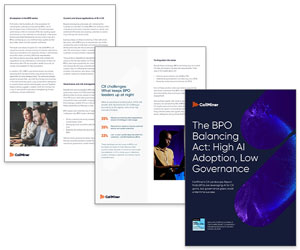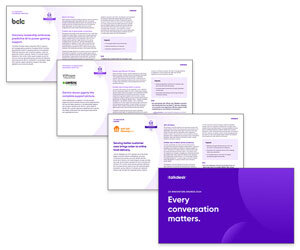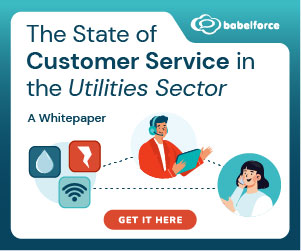Celia Cerdeira at Talkdesk discusses what makes a strong banking customer experience, explore strategic opportunities for improvement, and offer actionable insights for optimizing CX across the customer journey.
Roughly 60% of customers trust their bank to guide them through the next financial downturn. That trust soars to over 80% among those who are highly satisfied with their customer experience (CX).
Banks that prioritize customer experience aren’t just keeping customers; they’re outpacing competitors in growth, profitability, and brand strength.
As financial services grow increasingly commoditized, customer experience management in banking has become a primary driver of differentiation and loyalty.
New generations of digital-first users, rising expectations for convenience, and the competitive pressure from fintechs are forcing banks to rethink legacy processes and technologies. Static CX strategies no longer cut it.
What is Customer Experience in Banking?
Customer experience in banking covers every interaction a customer has with a financial institution, whether it’s checking a balance, applying for a loan, or getting help with an issue.
It includes both digital and human touchpoints, including the usability of a bank’s online portal, the design and functionality of its mobile app, the clarity of its communications, and the responsiveness of its support teams.
Behind the scenes, customer experience management in banking involves a strategic, organization-wide effort to understand what customers expect and then deliver it consistently across every channel.
That means using tools like customer feedback, behavioural data, and journey mapping to eliminate pain points, personalize interactions, and improve satisfaction.
Why is Banking CX Important?
A strong banking customer experience is critical for financial institutions because it directly influences customer acquisition, retention, and lifetime value.
In a market where products and pricing often look similar across banks, CX becomes the differentiating factor. Customers are more likely to choose, and stay with, a bank that makes their financial lives easier, more transparent, and less stressful.
By investing in thoughtful CX strategies, banks can reduce churn, increase referrals, and drive more engagement across high-value services like mortgages, credit, and investments.
Improving CX in Banking: Tools and Technologies to Consider
Improving customer experience in banking demands the right mix of tools and technologies that streamline operations, personalize interactions, and meet customers where they are. Let’s explore some of the most impactful solutions banks can implement to elevate their CX strategy.
AI and Machine Learning
Artificial intelligence (AI) and machine learning (ML) are transforming how banks understand and serve their customers, making experiences faster, smarter, and more personalized.
By analysing customer behaviour, preferences, and interaction history in real time, these technologies help banks anticipate needs and proactively deliver relevant support or product recommendations.
One key application is intelligent routing, which uses AI to match customers with the most appropriate resource, whether that’s a human representative or a self-service article.
This minimises wait times, reduces friction, and ensures that every customer lands exactly where they need to be, faster.
Customer Experience Automation
Customer experience automation simplifies routine interactions and backend processes. This includes everything from sending real-time alerts and onboarding messages to automating account updates, payment confirmations, and appointment scheduling.
By removing the need for manual intervention in repetitive tasks, banks can improve accuracy, reduce response times, and ensure that every step of the journey is handled on time.
Beyond operational efficiency, automation also supports personalization at scale. With tools like behavioural triggers, dynamic workflows, and contextual chatbots, banks can deliver tailored messages and recommendations based on a customer’s unique journey.
Data Privacy and Security
As digital banking becomes the norm, the volume of sensitive customer data being exchanged online continues to grow, along with the risk of cybercrime.
From phishing attacks to theft and account breaches, financial institutions are prime targets for cybercriminals.
That’s why customer experience in banking relies on convenience, personalization, and confidence that banks protect their data.
To safeguard that trust, banks are implementing advanced security measures and privacy protocols. These include multi-factor authentication (MFA), end-to-end encryption, biometric authentication, and real-time fraud detection algorithms powered by machine learning.
Many institutions also employ zero-trust security frameworks and continuous monitoring to proactively detect and neutralize threats before they impact customers.
Omnichannel Banking and Engagement
Omnichannel engagement provides customers with seamless access to financial services across multiple platforms, such as mobile apps, desktop portals, phone support, ATMs, and in-branch experiences.
This approach greatly improves the banking experience by giving customers flexibility and control over how they manage their finances.
For example, a customer can start an inquiry on a smartphone, continue it on a desktop, and complete it at a branch, without having to repeat their situation or go through the same steps again.
Customer Data Analytics
Customer data analytics plays a crucial role in improving customer experience in banking. By analysing transaction history, service interactions, digital behaviour, and demographic data, banks can better understand what their customers need, often before the customer asks for it.
This allows institutions to deliver more personalized product recommendations and proactively address issues that may affect satisfaction or loyalty.
Beyond personalization, data analytics helps banks identify patterns and pain points across the customer journey.
Whether it’s uncovering why customers abandon online account openings or understanding which features in the mobile app go unused, analytics can guide customer experience improvements with precision.
Mobile and digital banking.
Mobile and digital banking platforms offer customers instant, 24/7 access to essential financial services, from transferring funds and paying bills to tracking spending and depositing checks.
A well-designed digital experience reduces the need for branch visits and call centre support, giving users greater control over their finances on their own time and terms. That kind of accessibility is a major driver of satisfaction and loyalty in the modern banking customer experience.
24/7 Self-service support.
Round-the-clock self-service options give customers the freedom to handle routine tasks and find answers on their own.
Whether it’s resetting a password, updating personal details, or browsing FAQs, these tools let users resolve issues quickly without needing to wait for a representative.
An essential part of modern self-service is the use of customer service chatbots. Chatbots enhance accessibility, reduce wait times, and make support feel more intuitive and responsive.
Creating a Banking CX Strategy: Four Steps to Prioritize
Creating a strong banking customer experience strategy starts with a clear, customer-first approach. Below are four essential steps every financial institution should prioritize.
1. Capture the Right Customer Information
The foundation of any successful banking customer experience strategy is a deep understanding of customer needs, preferences, and pain points.
That begins with capturing the right information early on, through thoughtful data collection methods like surveys, feedback forms, and real-time customer interaction tracking.
Rather than relying solely on “yes or “no” questions, banks should use open-ended survey questions to explore how customers feel about specific experiences, such as mobile app usability, service wait times, or clarity of communication.
With these insights, financial institutions can map the full customer journey, identify where friction occurs, and prioritize the areas that need immediate attention, whether it’s the digital interface, onboarding process, or frontline support.
2. Introduce the Right CX Improvements
Once customer insights are in hand, the next step is to act on them by introducing the right banking customer experience improvements, strategically and in phases. A full CX overhaul can be overwhelming, so it’s smarter to start with the highest-impact touchpoints.
For example, if feedback highlights frustration with mobile banking, improving the app’s usability, speed, or navigation should be a top priority.
Similarly, if customers cite delays in service resolution, it may be time to upgrade support tools or introduce AI-powered chat.
Every change should be gradual and tested with real users to validate its effectiveness. Pilot programs, A/B testing, or incremental rollouts allow institutions to make adjustments based on live customer input and minimize disruption.
3. Train CX Agents, and Employees, to Prioritize CX
A successful banking customer experience strategy depends on tools, technology, and people. Employees, whether they’re frontline support agents, branch staff, or back-office specialists, shape the quality of every customer interaction.
That’s why CX training should be a company-wide priority, not just limited to customer service teams.
As banking becomes more digital, training should also address how to support customers through online platforms while maintaining a human touch.
Everyone in the organization should understand how their role impacts the customer journey and contribute to a more thoughtful, responsive experience.
4. Use Technology to Improve CX Efficiency
To meet rising expectations for speed and simplicity, financial institutions must leverage technology that enhances both customer experience in banking and operational efficiency.
Prioritizing tools like AI-powered analytics, intelligent routing, and real-time support platforms allows banks to optimize service delivery while reducing manual workloads.
These technologies can quickly surface trends, identify recurring pain points, and even predict customer behaviour enabling faster, more targeted responses.
Banking Customer Experience Trends Worth Watching
As expectations shift, so does the future of banking customer experience. Check out these key trends worth watching to stay ahead of evolving customer needs.
AI-Powered Tools and Automated Financial Insights
Digital channels have become the preferred way for customers to manage their finances, with people across all age groups and regions expecting seamless, personalized experiences.
In fact, 84% of banking customers say they would likely switch to a bank that offers timely, relevant advice to improve their financial health, especially if it includes AI-driven insights and product recommendations.
While financial institutions have generally been slower to fully embrace digital transformation compared to other industries, customer demand for convenient, digital-first banking experiences continues to grow rapidly.
If banks want to keep up, they will need to adopt automation to turn routine transactions into meaningful interactions that drive loyalty and ultimately lead to more profitable customer relationships.
Renewed Trust in Financial Security
Data breaches, identity theft, unauthorized transactions, or poor responses to fraud-related issues are a risk to trust in financial institutions.
With the increasing digitization of banking services, many customers worry about how their sensitive information is being stored, shared, and protected.
A single incident, whether it’s a phishing scam or a delayed fraud alert, can leave customers feeling vulnerable and skeptical about a bank’s ability to safeguard their finances.
To rebuild and reinforce this trust, banks are embedding security into their broader customer experience strategies. This includes implementing transparent communication around privacy policies, offering real-time fraud alerts, and making multi-factor authentication a standard feature.
Customer Sentiment Analysis
Understanding how customers feel, not just what they do, is essential to delivering a successful banking customer experience.
While traditional metrics like net promoter score (NPS), customer satisfaction score (CSAT), and customer effort score (CES) provide valuable insights, they often miss the nuances of emotion, frustration, or satisfaction expressed throughout the customer journey.
Interaction analytics measures sentiment to help create a more holistic view of customer interactions. When combined with behavioural data, sentiment insights allow financial institutions to pinpoint which touchpoints spark delight, and which cause friction. This enables more strategic, emotionally intelligent CX improvements that go beyond surface-level fixes.
Institution-Wide Focus on Customer Success
Delivering an exceptional customer experience in banking isn’t just the responsibility of frontline teams; it requires alignment across the entire organization.
From product development and IT to compliance and marketing, every department plays a role in shaping the customer journey.
When all teams are unified around the shared goal of customer success, banks can break down silos, respond to issues faster, and create more seamless, personalized experiences across every channel.
Personalised Customer Interactions
Leading financial institutions are embracing personalization as a core strategy to enhance the banking customer experience and boost retention.
By leveraging data from customer behaviour, preferences, and past interactions banks can tailor everything from product recommendations and marketing messages to service responses and financial advice.
Whether it’s offering a savings plan that aligns with a customer’s goals or proactively suggesting credit limit adjustments based on spending habits, personalization makes each interaction feel more relevant and valuable.
What Are the Benefits of an Optimized Banking Customer Experience?
Let’s touch on some of the key benefits of implementing an optimized banking customer experience.
- Improve customer satisfaction – Delivering smooth, helpful, and personalized interactions leads to happier, more confident customers.
- Increase customer loyalty – A consistently positive experience keeps customers engaged and less likely to switch to competitors.
- Protect brand reputation – Strong CX reduces negative reviews and customer complaints, enhancing the bank’s public image.
- Accelerate customer service efficiency – Automated tools and well-designed support systems allow for quicker resolutions and reduced operational costs.
- Protect regulatory compliance – A well-managed CX framework ensures that interactions meet legal and ethical standards, reducing risk exposure.
- Boost employee satisfaction – Empowering teams with the right tools and clear CX goals leads to better morale and more meaningful work.
- Enhance customer lifetime value (CLV) – Positive experiences foster long-term relationships, leading to higher lifetime profitability per customer.
When banks deliver consistently positive experiences, they not only retain existing customers but also attract new ones through word of mouth and strong brand reputation.
As customer expectations continue to rise, institutions that invest in CX are better positioned to stand out in a crowded market, ultimately leading to increased market share.
What Are the Challenges to Improving Customer Experience in Banking?
While the benefits of a strong banking customer experience are clear, the path to achieving it can have its share of hurdles. Check out some of the challenges financial institutions can encounter when working to improve customer experience.
- Legacy systems and infrastructure – Outdated technology that’s deeply embedded in core operations makes upgrades time-consuming.
- Technological complexity – Even when new tools are introduced, they often require extensive customization and training across departments, delaying implementation and adding operational friction.
- Rising customer expectations – With rapid innovation in fintech and digital services, customers expect seamless, personalized, and fast experiences forcing banks to constantly re-evaluate and adapt.
- Cybersecurity concerns – As more services go digital, the pressure to protect sensitive customer data intensifies, requiring robust systems to detect, prevent, and respond to threats like phishing and fraud.
- Serving multigenerational users – Banks must design experiences that meet the needs of digitally native customers without alienating older or less tech-savvy demographics.
This blog post has been re-published by kind permission of Talkdesk – View the Original Article
For more information about Talkdesk - visit the Talkdesk Website
Call Centre Helper is not responsible for the content of these guest blog posts. The opinions expressed in this article are those of the author, and do not necessarily reflect those of Call Centre Helper.
Author: Talkdesk
Reviewed by: Jo Robinson
Published On: 2nd Sep 2025
Read more about - Guest Blogs, Celia Cerdeira, Talkdesk






 Talkdesk is a global customer experience leader for customer-obsessed companies. Our contact center solution provides a better way for businesses and customers to engage with one another.
Talkdesk is a global customer experience leader for customer-obsessed companies. Our contact center solution provides a better way for businesses and customers to engage with one another. 


































